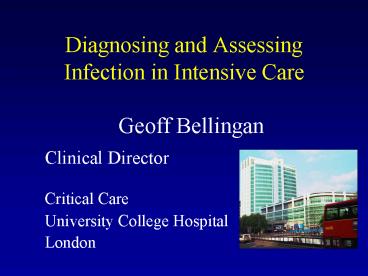Diagnosing and Assessing Infection in Intensive Care - PowerPoint PPT Presentation
1 / 25
Title:
Diagnosing and Assessing Infection in Intensive Care
Description:
Skin integrity operations, wounds, ulcers, poor perfusion, central lines, ... Anaesthesia. 2004 Sep;59(9):885-90. Systemic Digestive tract Decontamination (SDD) ... – PowerPoint PPT presentation
Number of Views:32
Avg rating:3.0/5.0
Title: Diagnosing and Assessing Infection in Intensive Care
1
Diagnosing and Assessing Infection in Intensive
Care
- Geoff Bellingan
- Clinical Director
- Critical Care
- University College Hospital
- London
2
Why Intensive Care is Different
3
Why Intensive Care is Different
Skin integrity operations, wounds, ulcers, poor
perfusion, central lines, drains, tubes,
catheters, stomas
4
Why Intensive Care is Different
- Information base is insufficient - tens at
most hundreds in trials - Impact of multiple organ dysfunction, renal
failure, liver failure etc. - Impact of drugs infusion of Propofol,
Adrenalin, Pancuronium, Clonidine, inhaled NO
etc - How fundamental is early treatment?
- How long to give antibiotics for?
- When to give combinations?
- What to do if have multi-resistant pathogens?
5
The Lung
- Common
- Community Acquired Pneumonia (5 -6 of
admissions) - Ventilator Associated Pneumonia common (1/day)
- Diagnosis difficult
- CAP easier than VAP
- No gold standard
6
ICNARC Study RESULTS
17,869 cases identified 5.9 of all ICU admissions
59 no microbial aetiology 49 bacterial 2 viral
Woodhead, Welch, Harrison, Bellingan, Ayres.
Critical Care Medicine 2006
7
Community Acquired Pneumonia
- CURB 65 Mortality
- 0 0.7
- 1 3.2
- 2 13
- 3 17
- 4 41.5
- 5 57
8
- Clinical criteria for VAP
- New or progressive infiltrates on CXR
- 2 or more of the following
- Fever (gt 38.3C)
- Leukocytosis (gt 10 or lt4)
- Purulent tracheobronchial secretions.
9
The modified clinical pulmonary infection
score Points 0 1 2 Tracheal
secretions Rare Abundant Abundant
purulent CXR infiltrates None Diffuse
Localized Temperature, C normal gt38.5 gt39
or lt36 WBC normal lt4 or gt11 gt500 band
forms PaO2/FiO2, gt 240 or ARDS lt240 and no
ARDS Microbiology Negative Positive
10
Clinical scores have been somewhat disappointing
Despite sensitivities of approximately 90,
specificity may be less than 50 1.
Ventilator associated pneumonia. Bellingan and
Al-Khafaji. In Encyclopedia of Respiratory
Medicine Laurent and Shapiro. 2006.
11
Inflammation vs. Infection
- Patients with late ARDS
- fever (90 ),
- leukocytosis (90 ),
- new localized infiltrate (80 ),
- purulent tracheal secretions (90),
- low systemic vascular resistance (50 ),
- Positive gallium scan (100 )
- BUT. but no source of infection identified
- even with open lung biopsy!.
- Meduri Fibroproliferative phase of ARDS.
Clinical findings and effects of corticosteroids
Chest. 1991.
12
The Ventilator itself can be causing the damage!
13
- Protected Specimen Catheter Brush and
Bronchoalveolar lavage in the diagnosis of VAP - In the absence of antibiotic treatment
- PSB - diagnostic threshold of gt103 CFU/ml,
- BAL - diagnostic threshold of gt105 CFU/ml.
- Pooled results show
- PSB has a sensitivity and specificity of _at_ 90
- BAL has a sensitivity of _at_ 53 - 93 and
specificity of _at_ 60 to 100.
Chastre J and Fagon J-Y Am. J. Respir. Crit.
Care Med. 2002.
14
Protected Specimen Catheter Brush and
Bronchoalveolar lavage in the diagnosis of VAP
- Improved accuracy over clinical criteria alone
but - False and false - remain significant
- Distal airways colonisation can occur
- Potential morbidity from lavage
- Significant technical aspects of quantitative
cultures - Poor association between bacterial load and
histologic damage.No threshold to separate
normal, bronchitis or pneumonia.
15
- Non-bronchoscopic, non-directed mini-BAL
- One paper - significant advantage vs BAL
- Three other studies - no difference
- Studies had different designs, limitations,
selection, controls, antibiotic treatment and
insufficient power.. - Never-the-less non-bronchoscopic, non-directed
mini-BAL techniques have sensitivities and
specificities of 60 to 100 and are comparable
with bronchoscopic methods.
16
Most clinicians still believe In the absence of
local enthusiasts, decision to treat should be
based on simple clinical criteria and the
short-term evolution of the condition After a
vigorous search for non-infectious conditions
mimicking VAP alternative non-pulmonary sites
of infection.
17
Colonisation and infection
18
Increasing Incidence of MRSA
3000
2500
2000
No
1500
1000
500
0
1987
1988
1989
1990
1991
1992
1993
1994
1995
1997
1996
Lowy F. N Engl J Med 1998339520-532
19
MRSA acquisition in the ICU?
Country
Acquiring MRSA in ICU
Colonised on admission
20
Current recommendationsre MRSA control
- Contact precautions
- Handwashing
- Gloves, gown/apron
- Screening
- Isolation
21
Cepeda et al Lancet 2005
22
Influence of drugs commonly used in the ICU.
23
28-DAY SURVIVAL FOR STEROIDS IN SEPTIC SHOCK
(n299)
ALL PATIENTS
STEROIDS 47
Cumulative survival rate
PLACEBO 39
p0.01
0
7
14
21
28
days
24
Antibiotics
- In UK ICU median duration of antibiotic therapy
is 6 days - Range 0 to 29 days!!!!
- Similar for both community and nosocomial
acquired infections. - Anaesthesia. 2004 Sep59(9)885-90.
25
Systemic Digestive tract Decontamination (SDD)
- Randomised prospective trial of 934 ICU patients
- Oral and enteral polymyxin , tobramycin, and
amphotericin 4-days iv cefotaxime. - ICU mortality 15 vs 23 (p0.002).
- Resistant Gram-negatives 16 SDD 26 control
(p0.001). - VRE 5 SDD and 4 controls
- No patients were colonised with MRSA
Lancet 2003































